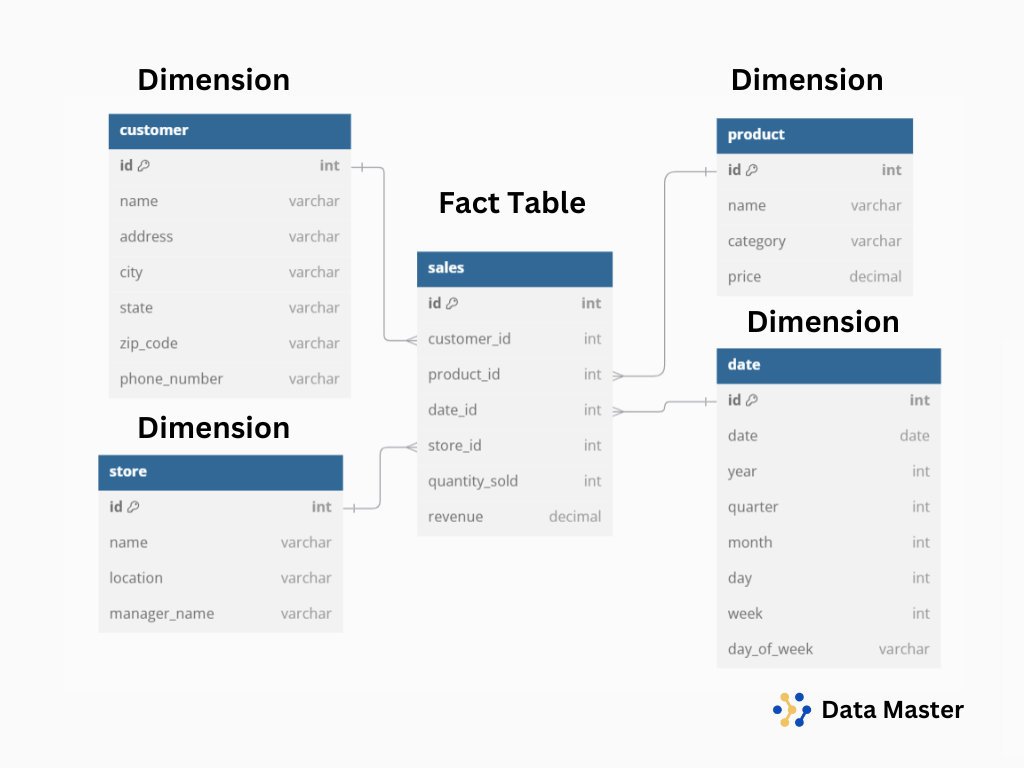In data warehousing, dimension tables provide the essential context that transforms raw data into meaningful insights. While fact tables store quantitative metrics, dimension tables hold descriptive attributes that allow users to filter, categorize, and explore data across multiple perspectives. Among the most common dimensions are Date, Product, and Customer—each playing a pivotal role in enriching analysis and enabling a multi-dimensional view of business data.
In this post, we’ll dive into these three critical dimensions, exploring their structure, attributes, and why they’re so essential in a well-designed data warehouse.
The Date Dimension: Enabling Time-Based Analysis
The Date dimension is fundamental in data warehousing, as almost every analysis benefits from a time-based perspective. Whether you’re tracking daily sales, comparing monthly performance, or analyzing year-over-year growth, the Date dimension enables time-based analysis across a range of granularities.
Common Attributes in the Date Dimension:
- Date Key: A unique identifier for each date, typically in an integer format like YYYYMMDD.
- Day, Month, Quarter, Year: These are essential for aggregating data at different time intervals.
- Fiscal Periods: Many businesses operate on fiscal calendars, making attributes like Fiscal Year and Fiscal Quarter crucial for accurate financial reporting.
- Holidays: Including holiday indicators (e.g., national or local holidays) helps track seasonal trends.
With these attributes, the Date dimension enables users to analyze metrics by various time periods, supporting trend analysis, seasonality studies, and year-over-year comparisons. To learn more about time-based hierarchies in dimension tables, check out our post on dimension tables.
The Product Dimension: Gaining Insights into Inventory and Sales
The Product dimension is essential for businesses that manage inventories, sell products, or analyze product performance. This dimension stores information about each product, making it easy to assess how different items, categories, or brands perform over time.
Common Attributes in the Product Dimension:
- Product Key: Unique identifier for each product.
- Product Name and Description: Basic information that identifies each item.
- Category and Subcategory: Grouping products into categories (e.g., Electronics > Smartphones) enables analysis at different levels.
- Brand: Tracking performance by brand is valuable for sales and marketing analysis.
- Price: Storing price history can provide insight into pricing trends and margin analysis.
For retail or e-commerce companies, analyzing sales by product dimension is key to understanding demand, managing inventory, and optimizing product mix. Our guide on fact tables shows how this dimension can be used alongside fact tables to track product-related metrics.
The Customer Dimension: Understanding Customer Behavior
The Customer dimension offers insights into who is buying your products, their demographics, and their purchasing behavior. This dimension is crucial for segmentation, personalized marketing, and customer lifetime value analysis.
Common Attributes in the Customer Dimension:
- Customer Key: A unique identifier for each customer, often a surrogate key.
- Name, Age, Gender: Basic demographic information useful for segmentation.
- Location: Country, state, and city details to analyze geographic trends.
- Customer Segment: Identifiers for customer types, such as “VIP,” “New,” or “Loyal,” to assist in targeted marketing.
- Join Date and Last Purchase Date: Useful for analyzing customer lifecycle and engagement frequency.
Customer analysis enables businesses to understand who their most valuable customers are, analyze retention rates, and tailor marketing campaigns. To further explore how customer data is integrated into the broader data model, read our dimensional modeling basics post.
Best Practices for Designing Common Dimensions
To get the most out of these dimensions, follow these best practices:
-
Standardize Primary Keys
Use surrogate keys as unique identifiers in each dimension table to ensure consistency across fact tables. Surrogate keys provide stability even if natural keys (like Product ID) change. -
Incorporate Hierarchies
Adding hierarchies within dimensions allows users to drill down or roll up data easily. For example, a hierarchy in the Date dimension could span Year > Quarter > Month > Day, supporting analysis across multiple time frames. -
Handle Slowly Changing Dimensions (SCDs)
Some dimension attributes, like customer location or product price, may change over time. Applying Slowly Changing Dimensions (SCD) techniques—such as Type 1 (overwrite) or Type 2 (new record)—helps maintain historical accuracy. Our post on dimensional design covers how to handle changing data effectively. -
Optimize for Query Performance
Index frequently used columns, such as keys or category fields, to speed up querying. For high-performance reporting, consider using materialized views as we discussed in our optimization guide. -
Document Attributes and Usage
A clear data dictionary that defines each attribute and its purpose ensures users understand the data. This documentation also supports consistency and aids in training new analysts.
Conclusion
Date, Product, and Customer dimensions are essential building blocks in any data warehouse, adding context that transforms raw data into actionable insights. By structuring these dimensions effectively and following best practices, businesses can conduct meaningful analysis, track performance trends, and understand customer behavior.
For more information on building a dimensional model, explore our posts on Star vs. Snowflake schema design and declaring the grain in dimensional modeling to enhance your data warehousing knowledge.
Discover more from Data Master
Subscribe to get the latest posts sent to your email.



